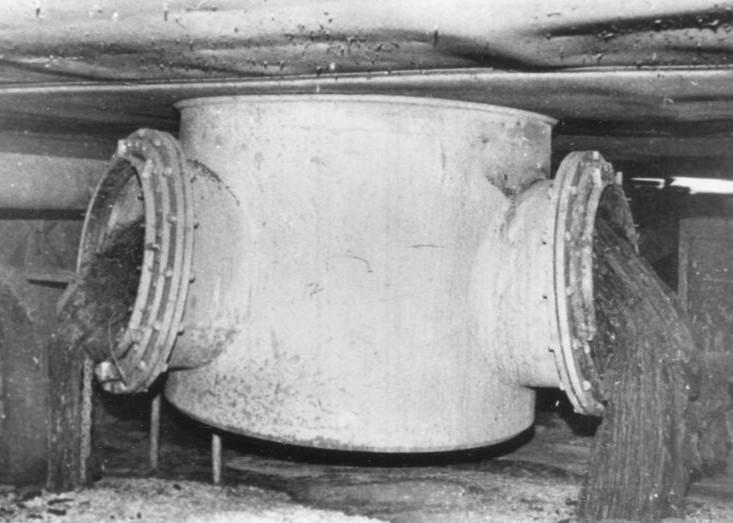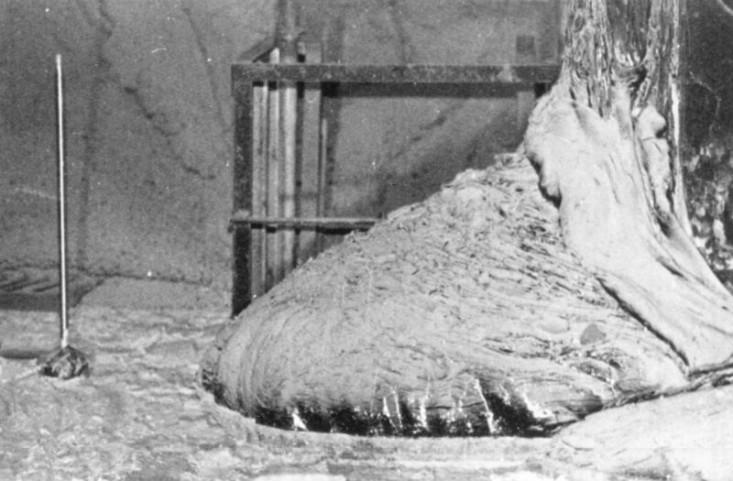The Elephants Foot Will It Explode Again
300 seconds volition produce a relatively quick death, which is better than many alternatives.
After simply xxx seconds of exposure, dizziness and fatigue will detect you a week afterwards. Two minutes of exposure andyour cells volition presently brainstorm to hemorrhage; four minutes: airsickness, diarrhea, and fever. 300 seconds and y'all have 2 days to live.
By the fall of 1986, the emergency crews fighting to contain the nuclear disaster at Chernobyl fabricated it into a steam corridor beneath failed reactor Number 4. Within this chamber they found blackness lava that had oozed straight from the cadre. The most famous formation was a solid flow that their radiations sensors firmly told them not to arroyo. With cameras pushed in from around a corner, the workers dubbed the dimly lit mass "the Elephant's Foot." According to readings taken at the time, the still hot portion of molten core put out enough radiation to give a lethal dose in 300 seconds.
The Elephant'southward Human foot could be the almost unsafe piece of waste in the globe.
Hot Zone
During a routine test on April 26, 1986, reactor Number 4 at the Chernobyl Nuclear Power Found experienced a power surge that triggered an emergency shutdown. It did non work. The attempt to manage the surge in power and the alarming increase in the core'due south temperature acquired an even larger power surge. Command rods that are used to manage core temperature were inserted besides belatedly. Their insertion into the hot core acquired the rods themselves to crack and fracture, locking them in identify. Rut and power output connected to rising until the water that was used to cool the entire reactor vaporized, generating massive amounts of pressure. The first explosion from the steam inside the reactor was enough to transport the four-million-pound chapeau of the reactor assembly through the roof of the building. Now catastrophically damaged, the remaining cooling water from broken channels seeped into the reactor as well, turning direct into steam as it touched the increasingly hot nuclear fuel rods. A second, even more massive explosion followed shortly after the first, belching broken core material into the air, spreading fire and radioactive detritus.
With a glowing centre no longer shielded past tons of steel and physical, the core could no longer be cooled. It began to melt.
When we say that a nuclear reactor "melts downwards," information technology's not simply illustrative language. The radioactive materials used equally fuel get hotter and hotter, due to their unstinting emission of high-free energy particles, until they literally melt, turning into something like lava. At Chernobyl, the loss of coolant acquired a meltdown of the fuel, some of which was scattered into the atmosphere. Much of it nevertheless, flowed into the bottom of the reactor vessel and somewhen melted through information technology. Oozing through pipes and eating through concrete, the radioactive lava menstruation from reactor Number 4 somewhen cooled plenty to solidfy. The result was a collection of stalactites and stalagmites, steam valves clogged with hardened lava, and the big black mass that would later be dubbed the Elephant's Pes.

A Deadly Game of Reddish Rover
Radioactive atoms are unstable atoms. While something like hydrogen is just fine with a nucleus consisting of one solitary proton, radioactive elements like uranium (the most common flavor, or isotope, contains 92 protons and 146 neutrons) is not so happy. Electrons, protons, and neutrons are emitted from the nuclei of these large atoms, transforming them, until something like plutonium degrades, over fourth dimension, into a stable chemical element like lead.
Particles emitted from radioactive atoms are a course of ionizing radiation —they accept enough energy to scramble atoms and molecules they crash into. (This is different from non-ionizing radiation , like the kind emitted by your cell telephone, which does non have enough free energy to break bonds.)
The reason that radiation can increment the risk of cancer is considering destructive particles are playing a mortiferous game of red rover in our bodies. Our Deoxyribonucleic acid is held in chromosomes—packets of billions of genetic building blocks holding hands in a chain, with astonishingly precise sequences. Just radiation can break upwardly the clasped hands, destroying or altering the bonds that hold DNA (and other important molecules) together. With enough damage to fundamental components, cells outset to function irregularly, leading to potentially lethal effects. For instance, the damage tin brand cells start reproducing uncontrollably, causing cancer.
The more radiation released from a mass of atoms, the more dangerous it is. Reports from Chernobyl estimated that the Elephant'south Foot was practically off the charts, putting out nearly 10,000 roentgens per hour. It takes nigh 1/10th of that to kill a person. In ane 60 minutes, the Elephant'southward Foot would expose you to the radiation of over four and a one-half 1000000 breast 10-rays. That dose is most 1,000 times stronger than exposures that have been clearly linked to increased cancer take chances. Considering of the way radiation damages homo cells—by knocking atoms and molecules out of place—decease by radiations is a relatively slow one. Up to a point, treatment helps. But high doses, like the kind delivered by shut contact with the Elephant'southward Foot, can't exist tolerated.
Quickly after the Chernobyl meltdown, nearly 600,000 workers descended on the site to help contain the escaping radiation. Knowingly or not, many of these workers were making the greatest sacrifice. More than thirty of them died within months following the incident, with many thousands more getting a full lifetime's dose of radiations, which is certain to crusade a significant increase in cancer rates.
Overexposed
After the nuclear fires were finally controlled, workers scrambled to contain the invisible dangers of the failed Chernobyl core. In May of 1986, structure began on the sarcophagus—a gigantic concrete enclosure built to seal off the radiation from the outside world. But it's not entirely sealed: The Chernobyl sarcophagus was outfitted with admission points assuasive researchers to observe the core and workers to enter.
That December, researchers discovered the Elephant's Human foot. Information technology was a couple of meters across, and it put out enough radiation to prevent anyone from getting about it for more than a few seconds. Just despite the dangers, nosotros take pictures of the deadly mass. How?
From a safe distance, workers—or "liquidators" as they were called—rigged up a crude wheeled camera contraption and pushed information technology towards the Elephant'due south Human foot. Careful examination determined that information technology wasn't all nuclear fuel. In fact, the mass was comprised of only a small percentage of fuel; the residuum was melted concrete, sand, and core shielding that all melted and flowed together. The material was dubbed "corium," later on the part of the reactor that spawned it. Over time, the Elephant's Human foot decomposed. Information technology puffed dust and its surface cracked. But for years it remained likewise unsafe to approach.
We don't know what happened to the photographers of the Elephant's Human foot, only nosotros exercise know that not every attempt to study it was as safe every bit wheeling in a photographic camera from around a corner. In some photos, we see a worker directly interacting with the mass. Samples had to be taken; more data about the foot was needed.

When this photo was taken, x years subsequently the disaster, the Elephant'due south Foot was simply emitting i-tenth of the radiation it once had. Still, only 500 seconds of exposure at this level would bring on mild radiation sickness, and a little over an hour of exposure would bear witness fatal. The Elephant'due south Pes is still dangerous, simply human curiosity and attempts to comprise our mistakes go on us coming dorsum to it.
Though the Chernobyl sarcophagus was constructed with enough physical to fill more than a 3rd of the Empire State edifice, the construction has since deteriorated and crumbled, threatening to re-expose the surrounding areas. Plans are underway to try brand certain that by 2015, the Elephant's Human foot will be fully contained again.
300 Seconds, 100 Years
Born of human mistake, continually generating copious rut, the Elephant's Foot is still melting into the base of the Chernobyl nuclear power establish. If it hits basis water, information technology could trigger another catastrophic explosion or leach radioactive material into the h2o nearby residents drink. Long after bleeding from the cadre, this unique piece of waste continues to exist a attestation to the potential dangers of nuclear ability. The Elephant's Foot will be in that location for centuries, sitting in the dark basement of a physical and steel sarcophagus, a symbol of one of humankind's most powerful tools gone amiss.
Kyle Loma is a freelance scientific discipline writer and blogger forScientific American who has contributed to Slate , Wired , Pop Science , Skeptical Inquirer , and io9 . He is a research fellow with theJames Randi Educational Foundation, and you can follow him on Twitter nether@Sci_Phile.
Source: https://nautil.us/chernobyls-hot-mess-the-elephants-foot-is-still-lethal-1408/#:~:text=Born%20of%20human%20error%2C%20continually,the%20water%20nearby%20residents%20drink.
0 Response to "The Elephants Foot Will It Explode Again"
Post a Comment